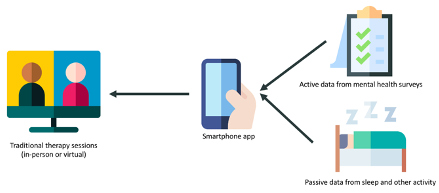Health
College Mental Health and COVID-19
How to use mobile technology to augment and extend care.
Posted October 2, 2020
This post was co-written with by college mental health lead Jennifer Melcher of the BIDMC Division of Digital Psychiatry at BIDMC.
The mental health of students remains a growing concern on college campuses. Students are experiencing elevated rates of depression, anxiety, and suicidal ideation, with recent CDC data revealing these trends are only worsening during the COVID-19 pandemic. 62.9% of survey respondents aged 18-24 (college-aged) met the criteria for an anxiety or depressive disorder and 25.5% of respondents reported that they had seriously considered suicide within the past 30 days. Colleges that previously struggled to meet the demand for face-to-face counseling on campus are now faced with the challenge of supporting students’ mental health remotely. There is a clear need for scalable digital technologies to support students’ mental health, yet even today, the resources that colleges are offering may not be lining up with students’ needs.
Our Research
Our research with college students has investigated 1) what colleges are offering as remote resources, 2) what students really want, and 3) how students interact and engage with digital mental health technologies.
Our review of digital mental health technologies currently offered by 60 college counseling centers across the country revealed that apps were the most popular option for colleges to offer to students. However, our team’s analysis of these apps that colleges offered to students in the spring of 2020 indicated that colleges’ app suggestions were problematic. A simple example of the problem — 28% of the suggested apps were discontinued or no longer available and 56% were outdated. The still available suggested apps presented privacy concerns for students as 39% did not have a privacy policy and 30% reported sharing user’s data with third parties. You can read more in the full paper here.
Students, meanwhile, have a strong idea of what they would like to see in a mental health app and there is little overlap with current offerings. Our team conducted interviews with 100 college students and found the four features most desired, which included that the app be free, safe, customizable, and credible. Students are budget-conscious and expect their school to either provide them with a subscription for a paid mental health app or suggest free resources. Data privacy is also on the top of students’ minds, especially when disclosing sensitive psychiatric information to a mental health app. Apps that don’t inspire trust are quickly left behind. Students also want apps that are customizable and offer them autonomy.
Finally, students want credible information. There are over 10,000 mental health-related apps on the app store and students are well aware that anyone can create an app and make it publicly available with little difficulty. To ensure they are investing their time into something that will work for them, college students want to see research-backing or an institutional affiliation to inspire trust and credibility. Our team has created the mHealth and Index and Navigation Database (MIND) as a way to sort through these apps. You can read more about our interviews with 100 college students and their preferences in apps with the full paper here.

Next Steps
Apps have traditionally been offered as self-help tools, but there is potential for them to serve as a clinical tool in college counseling centers so that colleges can reach and support remote students. There were many ways to use apps in care, and we offer our own digital clinic as one of several models. One way to make apps more useful is to consider them as more than tools to offer interventions, but also tools to help gather mental health information. Digital phenotyping involves the use of smartphone technology to collect passive data from the phone’s sensors (i.e. step count or sleep data) and active data from user interactions with the phone (i.e. answering surveys about anxiety).
Together, passive and active data can help offer a real-time picture of how thoughts, behaviors, and the environment uniquely impact mental health for each person. This can help drive more personalized and preventive mental health — something college mental health is primed to benefit from. Our digital clinic uses this approach, customized to the preferences and needs of our patients when serving patients, including college students. Our review of the existing research on digital phenotyping in college students highlighted that this technique is highly feasible and particularly well suited to college students and offers many examples of how this new approach to care can help.

Learn more and reach out at The Division of Digital Psychiatry.


